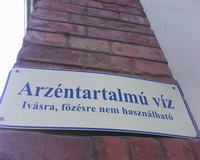Team:Debrecen-Hungary/arsenic
From 2010.igem.org
|
Arsenic Side projectInorganic arsenic is a potent human carcinogen and toxicant which people are exposed to mainly via drinking water and food. While originally thought that it is not a global problem, according to research presented at the annual Royal Geographical Society meeting in London in 2007 the problem is bigger than earlier suspected, and it affects nearly 140 million people in more than 70 countries. For the full story read [http://www.nytimes.com/2007/08/30/world/30arsenic.html?scp=1&sq=arsenic%20in%20drinking%20water&st=cse here].
The current situation of the arseinc problem in the drinking water of the south east region of Hungary can be found here:[http://www.springerlink.com/content/q666u6412x62276l/fulltext.pdf Arsenic in drinking water and mortality in the Southern Great Plain, Hungary]. Although Hungary has already invested huge sums of money to reduce arsenic levels in the water the strict European threshold value is still not reached by the drinking water in some places. We decided that the undergraduate students of our team should focus on the testing of the iGEM Biobrick componenets of the 2010 distribution and test it on water samples collected by Lilla Ozgyin in Békéscsaba.
Locations of the collection:
5600 Békéscsaba, Madách utca, Hungary.
By now a set of samples is being collected and we will share our real world samples with the Edinburgh team in order to provide a collection of water samples that could be tested in field very easy with this biological sensor. One of the obstacles of the 'in field' testing is that due to strict EU regulation genetically modified organisms, such as this arsenic biosensors are strictly forbidden to be taken out of the laboratories, e.g. in the place where the contamination exists. Further articles about the Arsenic problem can be found in NCBI Pubmed website [http://www.ncbi.nlm.nih.gov/pubmed/16395480 1], [http://www.ncbi.nlm.nih.gov/pubmed/18983000 2].

|
 "
"
 Team
Team
